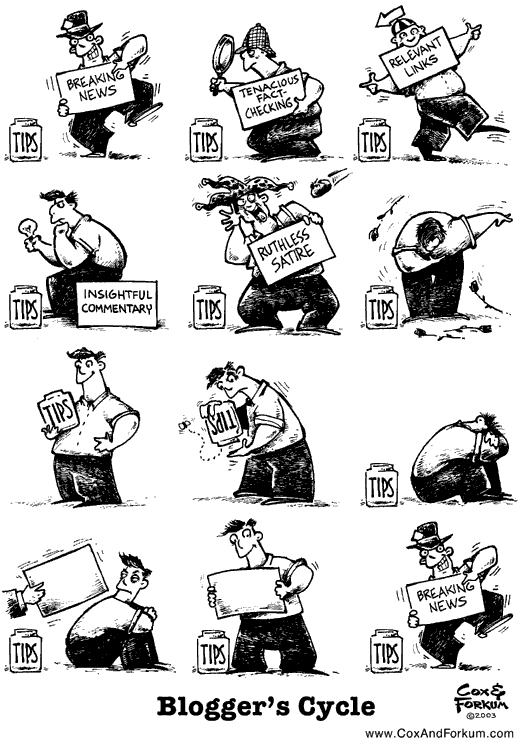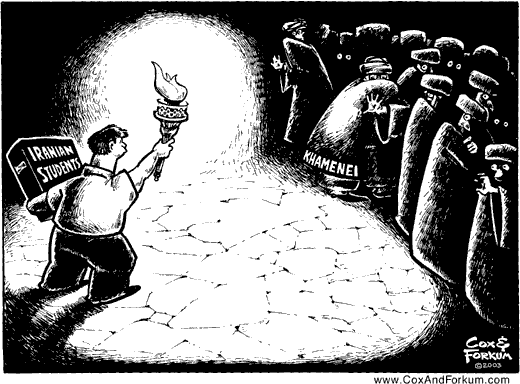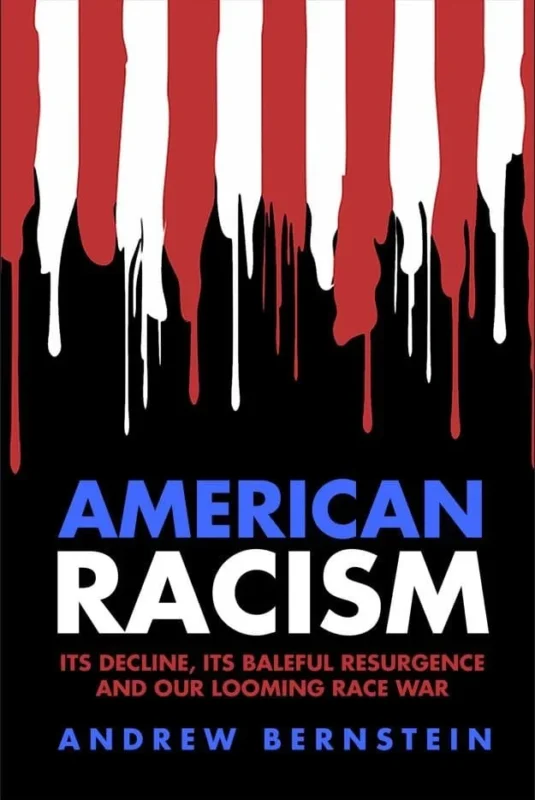I first noticed Cox & Forkum when I spotted a cartoon called “The Blogger’s Cycle.” I thought, “Wow. These guys nailed me! I could have written this myself, if only I were that clever and talented.”

I immediately read the rest of the Cox & Forkum weblog, where I was astounded by the sharp, professional level of their work. As their web site explains, Allen Forkum generally writes the cartoons, while John Cox illustrates them. They’ve been collaborating together on various projects for many years, but have only recently branched out into political cartooning. Their work is currently unsyndicated, but they are self-publishing a book called Black & White World, which I’d put on my Amazon wish list if it were available through Amazon! I must say, they were a fun interview, and probably the easiest one I’ve ever done. –Dean
—
Q: Where do you guys hail from? Where do you live now?
FORKUM: I’m from the Nashville area, and that’s where I live now.
COX: I grew up all over. I was born in Pensacola, but by the time I graduated high school, we had lived in Cincinnati, Birmingham, Orangeburg, S.C., Houston, Denver, and finally Huntington, W.V. Today I live in Atlanta.

FORKUM: Since we have to collaborate from different cities, one might think we have a direct connection via the Internet. But we’re still using fax machines. I fax sketches to John. We discuss them by phone. He faxes back the roughs and finals. Technologically speaking, we’re stuck in the ’80s.
COX: That’s 1880s. I recently sold my mule for a pack of quill pens and a whole bunch of fancy white paper.

Q: I take it that you still use pen and ink, and then just scan the cartoons. What are your favorite art tools (pen, brush, inks, etc.)?
COX: I’ve always had a love affair with old materials: oil on canvas, woodcuts, charcoal on parchment. Pen and ink has a rich tradition, and I’ve been enjoying the chance to put my stamp on it along with my cartooning heroes: Michael Ramirez, Ben Sargent, Mike Peters, and Jim Borgman. I love the high-contrast nature of ink and the emphasis it puts on design. Our cartoons often require a certain “trickery” to pull off, so the challenge to raise the bar is fascinating to me. These days I use Faber Castell brush pens, Pigma Micron pens, Speedball steel-nib pens and smooth bristol board. I do all the pencil work with a 4H and a 2B…and a big, fat eraser.
Q: Your work is easily as good as most of what’s seen on newspaper editorial pages. Have you approached any of the newspaper syndicates, to see if they’d be interested in your work?

FORKUM: So far we’ve only approached one syndicate. We were fortunate enough to have a contact at a syndicate that I thought was a perfect match for our work, because they had many columnists that our cartoons would compliment. But they turned us down. This was very early on, before we had a lot of work to show. We need to re-submit to them as well as other syndicates, but we’ve been too busy maintaining our blog and trying sell our self-published book, Black & White World.
COX: Before we tried our hand at editorial cartooning, Allen and I created Captain Speewak!, a daily comic strip that spoofed science fiction/adventure serials. It had ray guns, evil alien empires, idealistic heroes, disembodied tyrants and, of course, a large space ship shaped like a hand.

Sample Captain Speewak! cartoon. Previously unpublished.
None of the syndicates were interested in it. We still have a soft spot for the calamitous endeavor, so every once in a while it pops up in an editorial cartoon (e.g. “Leftists in Space“). Maybe Speewak will see the light of day when there’s an audience for goofy space characters who do battle against intergalactic socialism.
Q: Ever think about doing much with color in your cartoons?
COX: When it comes to bold, exaggerated cartooning, color can be a distraction. Black-and-white work seems to have the most emotional possibilities. It’s probably why I prefer black-and-white photography–and zebras.
Q: You don’t cartoon full-time, so what do you do when you’re not cartooning?
COX: I raise gerbils and set them free.
No, actually, I show my paintings at a local gallery and do caricature gigs at many corporate functions.
FORKUM: My background is in graphic design. I’m co-owner and art director of a small newspaper publishing company, which is where John and I first collaborated on cartoons. The newspaper needed a monthly gag cartoon to accompany a humor column in Automotive Reports by a guy named Buster McNutt. That was in 1990 and we’ve been doing it ever since. By comparison, the Buster cartoons were and are light-hearted: Gorillas in tutus. Amish vs. Technology. Drive-thru plastic surgery. That sort of thing.
Q: Your description of yourselves on your weblog says the two of you met in art school. Where did you go to art school? When did you graduate–or did you?
FORKUM: We met at the Art Institute of Atlanta in 1983 in the Commercial Arts program. After a disappointing first year we decided, along with a few other students, to enroll at Dekalb Tech, which at the time had a highly-regarded commercial arts course. It was only a one-year program with no degree, but we learned a lot and ultimately graduated. I think we got certificates.

COX: Prior to that, I went to Marshall University just long enough to realize I wanted to go to an art school. After graduating from Dekalb, I hit the streets and landed a job at Cargill Wilson & Acree as a remarkably talented comp dude–which means I drew mock-ups of ads. Yeah, I know: the glamour is blinding.
Q: Noam Chomsky once said that curious green ideas sleep furiously. Do you think they do?
COX: Of course, but only when mysterious pink lizards harmonize silently.

Q: Your political cartooning seems to have begun primarily at The Intellectual Activist, and you say your cartoons are “inspired by” Objectivism, which is what Ayn Rand called her philosophy. To what extent would you consider yourselves to be Objectivists?
FORKUM: I’m an Objectivist.

COX: I’d be an Objectivist, too, if it weren’t for the funny hats.
But really, when I was 23, I read The Fountainhead and was utterly transfixed. (I remember insisting that Allen read it… GEEZ, he read the hell out of it!) I immediately quit my “second-hander” job at Cargill and began my freelance and fine art career. I’ve enjoyed Rand’s works ever since and find her emphasis on excellence and individualism a great source of creativity.
FORKUM: One reason I say “inspired by” is to indicate that we’re not trying to speak for Objectivism. Read Ayn Rand’s brilliant books for that. She advocated, among other things, reason, individualism, secularism, individual rights and free markets. The cartoons are usually created from that perspective. I’m also literally inspired by Objectivism, inspired to speak out against today’s irrationalism, whether it’s from leftists, conservatives or libertarians.

Q: I’ve long been under the impression that most Objectivists have their
senses of humor surgically removed. Thanks for clearing that up for me, but,
have you ever noticed that some Rand devotees are a little, uh, rigid?
FORKUM: If you mean “rigid” in the moral sense, Objectivists are rigid. That is, we take an uncompromising stance on absolute moral principles. Objectivism is steel compared to today’s rubbery moral relativism.

But if by “rigid” you mean “humorless,” that hasn’t been my experience. I have noticed that, because of Objectivism’s emphasis on logic and reason, many people assume that it shuns emotions all together, as if the goal is to be Mr. Spock. Some Objectivists may even mistake it in such a way. But the philosophy is about rationally pursuing one’s own happiness and having the moral right to do so. That requires passionate values and a love of life, which is what characterizes the Objectivists I know.
Q: A large number of self-described objectivists and libertarians firmly opposed the war in Iraq. Yet you have been generally supportive of the Bush administration’s war policies. Why the disconnect, do you think?

FORKUM: The disconnect is that Objectivists aren’t libertarians, not if they follow Ayn Rand’s ideas consistently. She explicitly rejected libertarianism as anarchism years ago, and today it’s even clearer why she did. Prominent libertarian organizations opposed the war with Iraq as meddlesome government intervention, as if all government action is inherently wrong.
Objectivism, however, holds that government is essential to a just society but must be limited to protecting individual rights. Such protection sometimes involves foreign intervention, such as waging wars against hostile enemies. If anything, it was a lack of intervention — from the Iranian hostage crisis to the USS Cole bombing — that emboldened the Islamist murderers of 9/11. Objectivists might disagree about military priorities, such as whether Iraq should have come before Iran, but none that I know were against war in principle. I recommend that people read the op-eds at the Ayn Rand Institute for more information.
Q: You seem to pick on Democrats more than Republicans. Why is that?
COX: I can’t draw elephants.
Actually, the leftists among Democrats are just hysterical to me. Their over-ripe sincerity must be lampooned.

FORKUM: Recently, a couple of the Democratic presidential candidates were bragging about spending time in jail, as if we’re still in the ’60s. It’s a real challenge to top that with a cartoon. But we do criticize both parties, mostly for their socialistic expansion of the government. It’s just that Democrats are generally worse about that than Republicans — though lately Bush seems to be trying to out left the left. And we’ve been critical of Bush on other issues, such as his push for a Palestinian state and his multilateralist tendencies.
Q: Many of your cartoons take a firmly pro-Israel stance. Why is that?

FORKUM: Our stance is that Israel, as a free country, has the right to militarily defend itself against terrorists, just as America does. Israel is hated by its enemies — both in the Middle East and in the West — for a number of reasons, not the least of which is anti-Semitism. But I think the primary reason is something Ayn Rand called “the hatred of the good for being the good.” For those who want Islamic fundamentalism to reign supreme, who despise individualism and capitalism yet envy its wealth and power, and who evade the blatant failure of their own socialistic ideals, Israel is a constant reminder of the truth — that a small, poor, newly-formed nation can grow into a prosperous, mighty nation by valuing freedom. That is also why America is hated.
COX: Yeah, what he said.
Q: Are either of you Jewish?
COX: I’m not.
FORKUM: Me neither. But I might be if it weren’t for the funny hats.
Q: Is there a difference, in your view, between patriotism and jingoism? If so, what is it?
FORKUM: I understand “jingoism” to be an irrational sort of patriotism, a nationalistic desire to wage war for war’s sake, to conquer weaker countries, to expand an empire, like Nazi Germany or Imperial Japan. But “patriotism” is simply a love of one’s country. In America’s case, that means a love of liberty and justice. Of course, to those who equate Bush to Hitler and America to an imperialist aggressor, patriotism and jingoism are probably indistinguishable.










